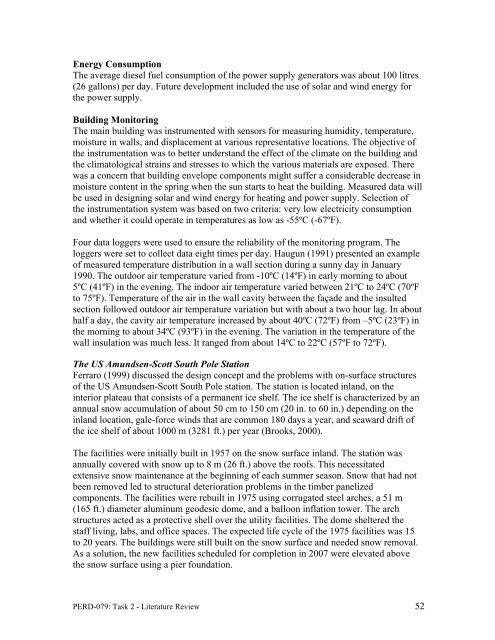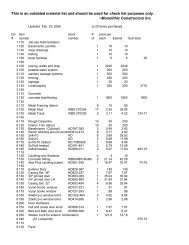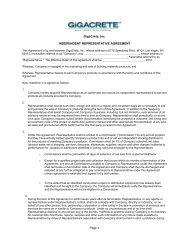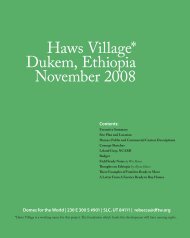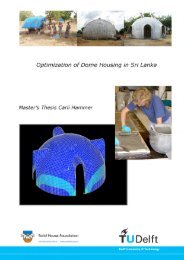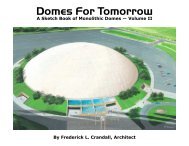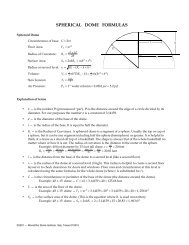Literature Review on Building Envelope, Heating and ... - Beeshive.org
Literature Review on Building Envelope, Heating and ... - Beeshive.org
Literature Review on Building Envelope, Heating and ... - Beeshive.org
You also want an ePaper? Increase the reach of your titles
YUMPU automatically turns print PDFs into web optimized ePapers that Google loves.
Energy C<strong>on</strong>sumpti<strong>on</strong><br />
The average diesel fuel c<strong>on</strong>sumpti<strong>on</strong> of the power supply generators was about 100 litres<br />
(26 gall<strong>on</strong>s) per day. Future development included the use of solar <strong>and</strong> wind energy for<br />
the power supply.<br />
<strong>Building</strong> M<strong>on</strong>itoring<br />
The main building was instrumented with sensors for measuring humidity, temperature,<br />
moisture in walls, <strong>and</strong> displacement at various representative locati<strong>on</strong>s. The objective of<br />
the instrumentati<strong>on</strong> was to better underst<strong>and</strong> the effect of the climate <strong>on</strong> the building <strong>and</strong><br />
the climatological strains <strong>and</strong> stresses to which the various materials are exposed. There<br />
was a c<strong>on</strong>cern that building envelope comp<strong>on</strong>ents might suffer a c<strong>on</strong>siderable decrease in<br />
moisture c<strong>on</strong>tent in the spring when the sun starts to heat the building. Measured data will<br />
be used in designing solar <strong>and</strong> wind energy for heating <strong>and</strong> power supply. Selecti<strong>on</strong> of<br />
the instrumentati<strong>on</strong> system was based <strong>on</strong> two criteria: very low electricity c<strong>on</strong>sumpti<strong>on</strong><br />
<strong>and</strong> whether it could operate in temperatures as low as -55ºC (-67ºF).<br />
Four data loggers were used to ensure the reliability of the m<strong>on</strong>itoring program. The<br />
loggers were set to collect data eight times per day. Haugun (1991) presented an example<br />
of measured temperature distributi<strong>on</strong> in a wall secti<strong>on</strong> during a sunny day in January<br />
1990. The outdoor air temperature varied from -10ºC (14ºF) in early morning to about<br />
5ºC (41ºF) in the evening. The indoor air temperature varied between 21ºC to 24ºC (70ºF<br />
to 75ºF). Temperature of the air in the wall cavity between the façade <strong>and</strong> the insulted<br />
secti<strong>on</strong> followed outdoor air temperature variati<strong>on</strong> but with about a two hour lag. In about<br />
half a day, the cavity air temperature increased by about 40ºC (72ºF) from –5ºC (23ºF) in<br />
the morning to about 34ºC (93ºF) in the evening. The variati<strong>on</strong> in the temperature of the<br />
wall insulati<strong>on</strong> was much less. It ranged from about 14ºC to 22ºC (57ºF to 72ºF).<br />
The US Amundsen-Scott South Pole Stati<strong>on</strong><br />
Ferraro (1999) discussed the design c<strong>on</strong>cept <strong>and</strong> the problems with <strong>on</strong>-surface structures<br />
of the US Amundsen-Scott South Pole stati<strong>on</strong>. The stati<strong>on</strong> is located inl<strong>and</strong>, <strong>on</strong> the<br />
interior plateau that c<strong>on</strong>sists of a permanent ice shelf. The ice shelf is characterized by an<br />
annual snow accumulati<strong>on</strong> of about 50 cm to 150 cm (20 in. to 60 in.) depending <strong>on</strong> the<br />
inl<strong>and</strong> locati<strong>on</strong>, gale-force winds that are comm<strong>on</strong> 180 days a year, <strong>and</strong> seaward drift of<br />
the ice shelf of about 1000 m (3281 ft.) per year (Brooks, 2000).<br />
The facilities were initially built in 1957 <strong>on</strong> the snow surface inl<strong>and</strong>. The stati<strong>on</strong> was<br />
annually covered with snow up to 8 m (26 ft.) above the roofs. This necessitated<br />
extensive snow maintenance at the beginning of each summer seas<strong>on</strong>. Snow that had not<br />
been removed led to structural deteriorati<strong>on</strong> problems in the timber panelized<br />
comp<strong>on</strong>ents. The facilities were rebuilt in 1975 using corrugated steel arches, a 51 m<br />
(165 ft.) diameter aluminum geodesic dome, <strong>and</strong> a ballo<strong>on</strong> inflati<strong>on</strong> tower. The arch<br />
structures acted as a protective shell over the utility facilities. The dome sheltered the<br />
staff living, labs, <strong>and</strong> office spaces. The expected life cycle of the 1975 facilities was 15<br />
to 20 years. The buildings were still built <strong>on</strong> the snow surface <strong>and</strong> needed snow removal.<br />
As a soluti<strong>on</strong>, the new facilities scheduled for completi<strong>on</strong> in 2007 were elevated above<br />
the snow surface using a pier foundati<strong>on</strong>.<br />
PERD-079: Task 2 - <str<strong>on</strong>g>Literature</str<strong>on</strong>g> <str<strong>on</strong>g>Review</str<strong>on</strong>g> 52


